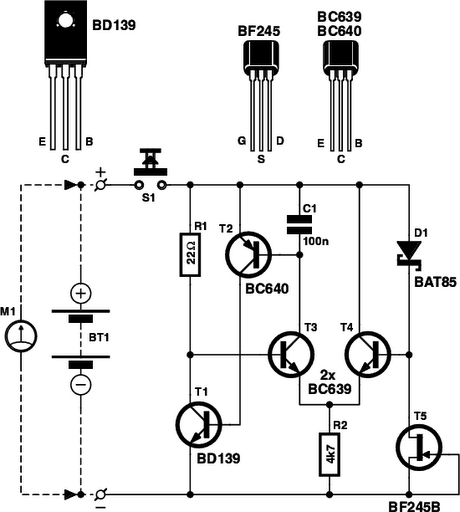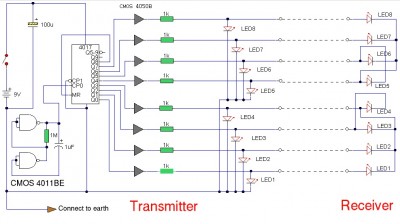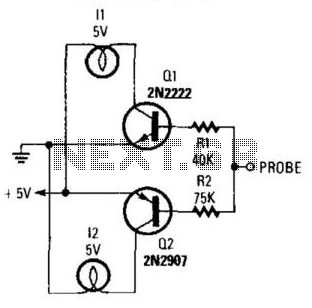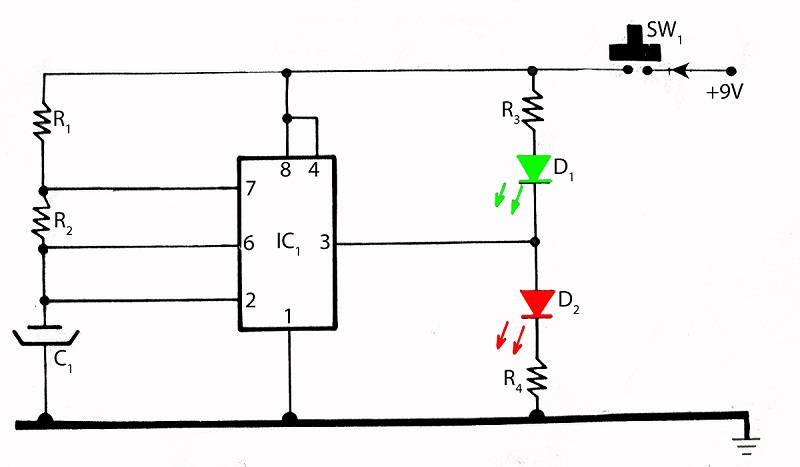
Logic test probe with memory
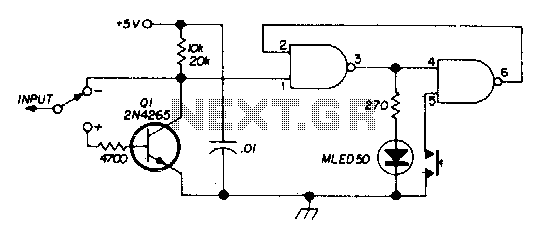
There are two switches: a memory disable switch and a pulse polarity switch. The memory disable switch is a push-button that resets the memory to a low state when pressed. The pulse polarity switch is a toggle switch that selects whether the probe responds to a high-level or pulse (+5 V) or a low-level or pulse (ground). More: Use IC logic of the same type as is being tested.
The circuit features two primary control elements: a memory disable switch and a pulse polarity switch. The memory disable switch is implemented as a momentary push-button switch. When activated, this switch generates a signal that resets the memory element of the circuit to a low state, effectively clearing any stored data or states. This function is crucial for applications requiring a fresh start or for troubleshooting purposes.
The pulse polarity switch, on the other hand, is a toggle switch that allows the user to select between two operational modes for the probe. One position of the switch configures the probe to respond to a high-level signal, specifically a +5 V pulse, which is commonly used in digital logic circuits to represent a logical '1'. The alternative position configures the probe to respond to a low-level signal, typically ground (0 V), representing a logical '0'. This versatility is essential for testing and verifying the behavior of integrated circuits (ICs) under different logic levels.
For effective operation, it is recommended to utilize integrated circuit (IC) logic that matches the type of logic being tested. This ensures compatibility and accurate performance during testing procedures. The circuit design should consider the specifications of the ICs used, including their input and output voltage levels, current requirements, and response times, to ensure reliable operation across various testing scenarios.
Overall, this circuit design provides a straightforward yet effective means of controlling memory states and signal polarity, making it a valuable tool for electronics testing and development.There are two switches: a memory disable switch and a pulse polarity switch. Memory disable is a push-button that resets the memory to the low state when depressed. Pulse polarity is a toggle switch that selects whether the probe responds to a high-level or pulse (+5 V) or a low-level or pulse (ground) (Use IC logic of the same type as is being tested).
The circuit features two primary control elements: a memory disable switch and a pulse polarity switch. The memory disable switch is implemented as a momentary push-button switch. When activated, this switch generates a signal that resets the memory element of the circuit to a low state, effectively clearing any stored data or states. This function is crucial for applications requiring a fresh start or for troubleshooting purposes.
The pulse polarity switch, on the other hand, is a toggle switch that allows the user to select between two operational modes for the probe. One position of the switch configures the probe to respond to a high-level signal, specifically a +5 V pulse, which is commonly used in digital logic circuits to represent a logical '1'. The alternative position configures the probe to respond to a low-level signal, typically ground (0 V), representing a logical '0'. This versatility is essential for testing and verifying the behavior of integrated circuits (ICs) under different logic levels.
For effective operation, it is recommended to utilize integrated circuit (IC) logic that matches the type of logic being tested. This ensures compatibility and accurate performance during testing procedures. The circuit design should consider the specifications of the ICs used, including their input and output voltage levels, current requirements, and response times, to ensure reliable operation across various testing scenarios.
Overall, this circuit design provides a straightforward yet effective means of controlling memory states and signal polarity, making it a valuable tool for electronics testing and development.There are two switches: a memory disable switch and a pulse polarity switch. Memory disable is a push-button that resets the memory to the low state when depressed. Pulse polarity is a toggle switch that selects whether the probe responds to a high-level or pulse (+5 V) or a low-level or pulse (ground) (Use IC logic of the same type as is being tested).
